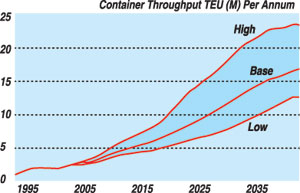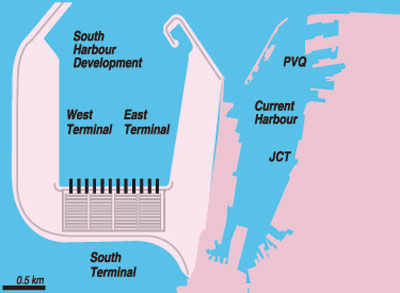Sunday Times 2
Colombo South Harbour: Progress stymied in a sea of indecision
View(s):By D. Godage
Colombo Port has earned the status as the hub port in the South Asian region primarily attributed to its strategic location to the south of the Indian subcontinent connecting the Middle East with the Far East, with links to the Australian and African continents. It is the gateway to South Asia. To cater to the increasing demand of services in the international shipping and to accommodate larger ships especially mega container carriers, an expansion of the port was deemed essential .Due to limitations of water depth and restricted size of the water basin of the existing port, which had been built over 130 years ago by the British, it became necessary to build a new water basin protected by breakwaters.
 This necessity for a new harbour basin was recognised in March 1995 when public invitations were made by the Ports Authority to private investors to build a new breakwater and container terminals to the West of the existing port at the southern end adjoining the Queen Elizabeth Quay –hence it was named Colombo South Harbour. The only proposal received in June 1995 was to take over the Queen Elizabeth Quay (QEQ) and convert it to a container terminal by widening the quay, and as the next step for the Government to build a new breakwater so that the investor would build a container terminal adjoining and behind the QEQ. Although it was an alternative offer not exactly in line with the intention of the Government, it was accepted.
This necessity for a new harbour basin was recognised in March 1995 when public invitations were made by the Ports Authority to private investors to build a new breakwater and container terminals to the West of the existing port at the southern end adjoining the Queen Elizabeth Quay –hence it was named Colombo South Harbour. The only proposal received in June 1995 was to take over the Queen Elizabeth Quay (QEQ) and convert it to a container terminal by widening the quay, and as the next step for the Government to build a new breakwater so that the investor would build a container terminal adjoining and behind the QEQ. Although it was an alternative offer not exactly in line with the intention of the Government, it was accepted.
The South Asia Gateway Terminal (SAGT) is the result of this exercise from 1999 but the new harbour concept got delayed. The Asian Development Bank (ADB) came forward to carry out a feasibility study and engaged an Australian Consultant in 2000 at a cost of about US$ 1.5 million in grant assistance. The final report received at the Ports Ministry in February 2002 proposed a 12-berth container handling port as a viable project. The ADB followed up with a Technical Assistance loan of US$ 10 million in November2001 to the Ports Ministry to proceed with detailed engineering designs and prepare all documentation needed to proceed with procurement process so as to implement the project soon. The Ports Ministry selected a reputed British engineering consultancy firm following a public tender procedure. All requisite documents including business plan, environmental impact assessment were completed by middle of 2005 but the project stagnated thereafter due to non-availability of funds required to construct a new breakwater.
In 2005, the ADB consented to provide US$ 100 million which was far too short as the estimated cost exceeded three times that. No other funding agency was willing to provide funds. The Finance Ministry’s advice at that time was to seek private sector funds or commercial loans. It was well known that the 1995 attempt to find a private investor to build a breakwater was a failure and also research had revealed that no private investor had built port infrastructure like a breakwater anywhere in the world. Such facts were of no concern to decision makers and the project did not progress.
 Attention was directed towards the Asian Development Bank again in the mid-2006, with a new management running the Ports Authority. After lengthy discussions with regard to ADB’s conditions and covenants and explanations as to why some of them could not be sustained, the ADB gradually increased the loan to US$ 300 million. The Loan Agreement was signed in April 2007 – a delay of about 2 years. This is a noteworthy and fortunate milestone of this important national project.
Attention was directed towards the Asian Development Bank again in the mid-2006, with a new management running the Ports Authority. After lengthy discussions with regard to ADB’s conditions and covenants and explanations as to why some of them could not be sustained, the ADB gradually increased the loan to US$ 300 million. The Loan Agreement was signed in April 2007 – a delay of about 2 years. This is a noteworthy and fortunate milestone of this important national project.
The public tender process thereafter was concluded and a Korean firm finally completed the project successfully. The Korean firm had quoted a price of about US$ 330 million while the next bid from a Chinese contractor was around US$ 570 million. With the government counterpart fund of about US$ 100 million along with the US$ 300 million loan fund, the construction of nearly 6 km long breakwaters with associated facilities was completed on time in April 2012. The protected water basin at 18m depth is around 285 hectares while entrance channel is at 20m water depth. This harbour could accommodate the world`s largest container ships now in operation. The harbour is designed to accommodate three large container terminals each on its South, East and West with designed capacity of 2.4million TEUs per annum.
The next urgent and essential step was to build and operate the terminals to sustain the hub status of Colombo and also to generate maximum revenue to the country including funds for loan repayment.The South Container Terminal (SCT) was the first of the three terminals opened for private sector offers. Five proposals came in, but because of a Cabinet decision, the process was stopped in March 2008 after spending over a year in the process. Fresh offers called thereafter drew only one offer in July 2009. Lengthy negotiations had resulted in signing of the Build Operate and Transfer (BOT) Agreement in August 2011 for private sector participation. Under a 35-year lease, the SCT is under the control of the Colombo International Container Terminals Limited (CICT), a joint venture established between the China Merchants Holdings International and the Sri Lanka Ports Authority where 15% share is held by the Ports Authority. The Terminal was partly operational in August 2013 and became fully operational around April 2014. CICT has been operating successfully as it handled 2 million TEUs in 2016 which was the second year of operation.
The Port of Colombo handled 4 million TEUs in 2010 and after the South Harbour came into action, the 5 million TEUs mark was surpassed in 2015 and recorded a figure of 5.735 million TEUs in 2016. The forecast presented in the Business Plan of Colombo South Harbour by the British Consultant in 2005 has three scenarios — Low, Base and High: Low represented poor growth in the region, High with very high growth and productivity among other factors and Base with average conditions. The Base case seems to be the real situation over the past decade.
The actual volumes handled over the past decade have been following the Base scenario of the forecast presented in 2005 (see graphic) and about 5 percent over the forecast level. More important suggestion in the forecast is that the next terminal should be operational in 2017 to avoid capacity constraints resulting in high berth occupancy and ship congestion. The Port of Colombo experienced congestion in the past with serious repercussions such as diversions and cancellation of ship arrivals. Those senior staff members in the Port will understand this situation and not those who never experienced such scenario.
The only way to avoid congestion situation is to operate the next terminal namely the East Container Terminal before 2018. Normally to select an investor it would take more than two years and thereafter to build and commission the terminal it would need at least three years. The present situation is that the Ports Authority has built about one-third of the total quay length of 1200m and part of the backyard area some time ago and it is idling without quay side and yard cranes. Ordering and installing the cranes would require at least 18 months. Thus commissioning of East Terminal on a partial basis is critical but would need at least 18 months. A map of the Colombo South Harbour with the completed terminal and proposed terminals is published here. But the part completed East Terminal portion is not marked.
Based on the traffic forecast given herein after the East Terminal operation there would be the saturation point reaching once again. The West Container Terminal should be operating by 2024 providing adequate capacity until about 2030. While the designed capacity of the three terminals in the South Harbour stands at 7.2 million TEUs reaching 9 million TEUs would not be impossible with technological advances in ships and handling methods.
The aims of the Colombo South Harbour as envisaged initially have been to create an efficient and internationally competitive port in Colombo by enlarging the Colombo Port and to accelerate the country’s economic development by creating an environment to expand private sector participation in the port sector thereby improving efficiency of public sector as well. How they are being achieved is yet to be seen.
(The writer was the Chief Engineer (Ports) SLPA, Managing Director SLPA and Project Director, Colombo South Harbour Project.)

